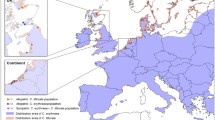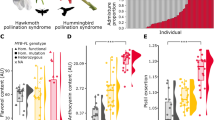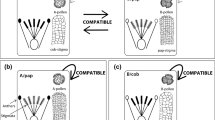Abstract
SPECIATION is the process whereby populations acquire sufficient genetic differences to become reproductively isolated1. Since Darwin it has been recognized that the tempo and mode of specia-tion are greatly influenced by the number and magnitude of genetic changes required for reproductive isolation2–6, but detailed genetic studies have been limited to a few taxa such as Drosophila7. Genome mapping techniques now widely adopted in plant8,9 and animal10,11 breeding make it possible to investigate the genetic basis of reproductive isolating mechanisms in natural populations. Here we use this approach to map eight floral traits in two sym-patric monkeyflower species that are reproductively isolated owing to pollinator preference by bumblebees or hummingbirds. For each trait we found at least one quantitative trait locus accounting for more than 25% of the phenotypic variance. This suggests that genes of large effect can contribute to speciation.
Similar content being viewed by others
References
Mayr, E. Animal Species and Evolution (Harvard Univ. Press, Cambridge, Massachusetts, 1963).
Maynard Smith, J. A. Rev. Genet. 17, 11–25 (1983).
Macnair, M. R. & Christie, P. Heredity 50, 295–302 (1983).
Barton, N. H. & Charlesworth, B. A. Rev. Ecol. Syst. 15, 133–164 (1984).
Gottlieb, L. D. Am. Nat. 123, 681–709 (1984).
Coyne, J. A. Nature 355, 511–515 (1992).
Coyne, J. A. Evolution 47, 778–788 (1993).
Paterson, A. H. et al. Nature 335, 721–726 (1988).
Stuber, C. W., Lincoln, S. E., Wolff, D. W., Helentjaris, T. & Lander, E. S. Genetics 132, 823–839 (1992).
Andersson, L. et al. Science 263, 1771–1774 (1994).
Georges, M. et al. Genetics 139, 907–920 (1995).
Vickery, R. K. Jr in Evolutionary Biology (eds Hecht, M. K., Steere, W. C. & Wallace, B.) 405–507 (Plenum, New York, 1978).
Grant, V. Proc. natn. Acad. Sci. U.S.A. 91, 10407–10411 (1994).
Hiesey, W. M., Nobs, M. A. & Bjorkman, O. Carnegie Inst. Washington Publ. 628 1, 1–213 (Washington DC, 1971).
Vickery, R. K. Jr Great Basin Naturalist 52, 145–148 (1992).
Faegri, K. & van der Pijl, L. The Principles of Pollination Ecology (Pergamon, New York, 1979).
Daumer, K. Z. vergl. Physiol. 41, 49–110 (1958).
Kevan, P. G. in Handbook of Experimental Pollination Biology (eds Jones, C. E. & Little, R. J.) 3–30 (Reinhold, New York, 1983).
Ott, J. Analysis of Human Genetic Linkage (Johns Hopkins Univ. Press, Baltimore, Maryland, 1985).
Zeng, Z.-B. Genetics 136, 1457–1468 (1994).
Williams, J. G. K., Kubelik, A. R., Livak, K. J., Rafalski, J. A. & Tingey, S. V. Nucleic Acids Res. 18, 6531–6535 (1990).
Werth, C. R. Virginia J. Sci. 36, 53–76 (1985).
Lander, E. S. et al. Genomics 1, 174–181 (1987).
Lander, E. S. & Botstein, D. Genetics 121, 185–199 (1989).
Hulbert, S. H. et al. Genetics 120, 947–958 (1988).
Paterson, A. H., DeVerna, J. W., Lanini, B. & Tanksley, S. D. Genetics 124, 735–742 (1990).
Author information
Authors and Affiliations
Rights and permissions
About this article
Cite this article
Bradshaw, H., Wilbert, S., Otto, K. et al. Genetic mapping of floral traits associated with reproductive isolation in monkeyflowers (Mimulus). Nature 376, 762–765 (1995). https://doi.org/10.1038/376762a0
Received:
Accepted:
Issue Date:
DOI: https://doi.org/10.1038/376762a0
- Springer Nature Limited
This article is cited by
-
Rapid genomic evolution in Brassica rapa with bumblebee selection in experimental evolution
BMC Ecology and Evolution (2024)
-
Genetic architecture of a pollinator shift and its fate in secondary hybrid zones of two Petunia species
BMC Biology (2023)
-
Mapping of flowering time, seed quality and clubroot resistance in rutabaga × spring canola populations and their association
Euphytica (2021)
-
Foliage affects colour preference in bumblebees (Bombus impatiens): a test in a three-dimensional artificial environment
Evolutionary Ecology (2017)
-
Small reductions in corolla size and pollen: ovule ratio, but no changes in flower shape in selfing populations of the North American Arabidopsis lyrata
Oecologia (2017)





